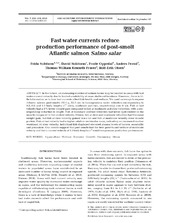| dc.contributor.author | Solstorm, Frida | |
| dc.contributor.author | Solstorm, David | |
| dc.contributor.author | Oppedal, Frode | |
| dc.contributor.author | Fernø, Anders | |
| dc.contributor.author | Fraser, Thomas | |
| dc.contributor.author | Olsen, Rolf Erik | |
| dc.date.accessioned | 2015-12-18T10:06:50Z | |
| dc.date.available | 2015-12-18T10:06:50Z | |
| dc.date.issued | 2015-09-17 | |
| dc.Published | Aquaculture Environment Interactions 2015, 7:125-134 | eng |
| dc.identifier.issn | 1869-7534 | en_US |
| dc.identifier.uri | https://hdl.handle.net/1956/10778 | |
| dc.description.abstract | In the future, an increasing number of salmon farms may be located in areas with fast water current velocity due to limited availability of more sheltered locations. However, there is little information as to how fast currents affect fish health and welfare. We used raceways to expose Atlantic salmon post-smolts (98.6 g, 22.3 cm) to homogeneous water velocities corresponding to 0.2, 0.8 and 1.5 body lengths s-1 (slow, moderate and fast, respectively) over 6 wk. Fish at fast velocity had a 5% lower weight gain compared to fish at moderate and slow velocities, with a corresponding reduction in length. Fish at moderate and fast velocities had lower lipid content in the muscle compared to fish at slow velocity. Hence, fish at slow and moderate velocities had the same weight gain, but fish at slow velocity gained more fat and fish at moderate velocity more muscle protein. Fish at fast velocity had a higher relative ventricular mass, indicating an increased cardiac workload. At slow velocity, individual fish displayed elevated plasma levels of lactate, osmolality and potassium. Our results suggest that post-smolts had the best growth and welfare at moderate velocity and that a current velocity of 1.5 body lengths s-1 could compromise production performance. | en_US |
| dc.language.iso | eng | eng |
| dc.publisher | Inter-Research | en_US |
| dc.relation.ispartof | <a href="http://hdl.handle.net/1956/16129" target="_blank">The effect of water currents on post-smolt Atlantic salmon, Salmo salar (L.). A welfare approach to exposed aquaculture</a> | en_US |
| dc.rights | Attribution CC BY | eng |
| dc.rights.uri | http://creativecommons.org/licenses/by/3.0 | eng |
| dc.subject | Aquaculture | eng |
| dc.subject | Stress | eng |
| dc.subject | Swimming | eng |
| dc.title | Fast water currents reduce production performance of post-smolt Atlantic salmon Salmo salar | en_US |
| dc.type | Peer reviewed | |
| dc.type | Journal article | |
| dc.date.updated | 2015-09-22T12:31:27Z | |
| dc.description.version | publishedVersion | en_US |
| dc.rights.holder | Copyright the authors 2015 | en_US |
| dc.identifier.doi | https://doi.org/10.3354/aei00143 | |
| dc.identifier.cristin | 1266152 | |
| dc.relation.project | Norges forskningsråd: 207116 | |
| dc.subject.nsi | VDP::Landbruks- og fiskerifag: 900::Fiskerifag: 920::Akvakultur: 922 | |
| dc.subject.nsi | VDP::Agriculture and fisheries science: 900::Fisheries science: 920::Aquaculture: 922 | |
| dc.subject.nsi | VDP::Matematikk og Naturvitenskap: 400 | en_US |

